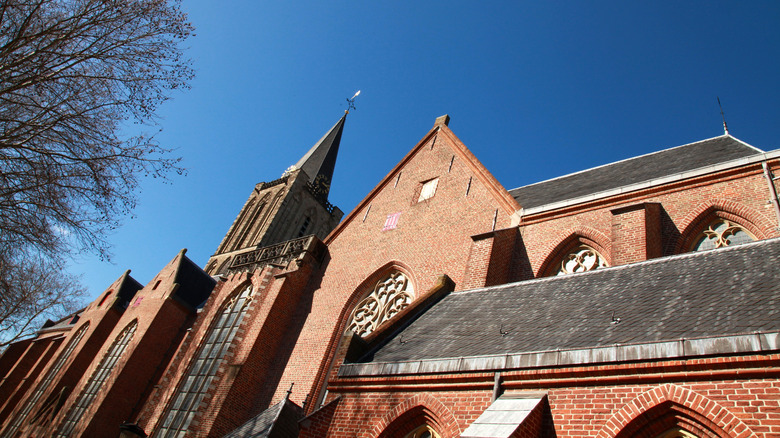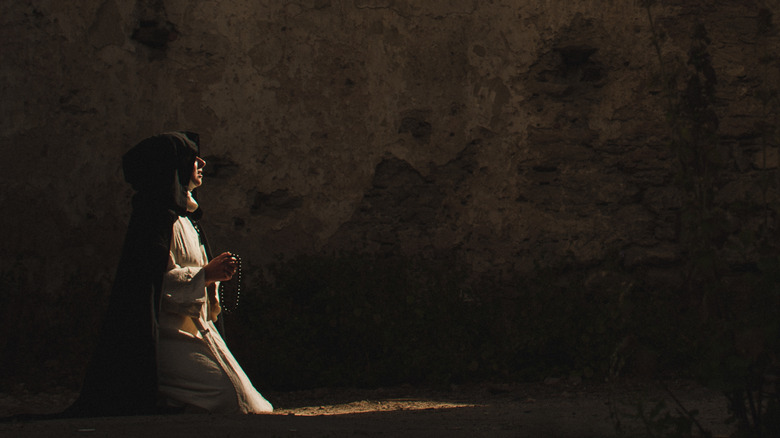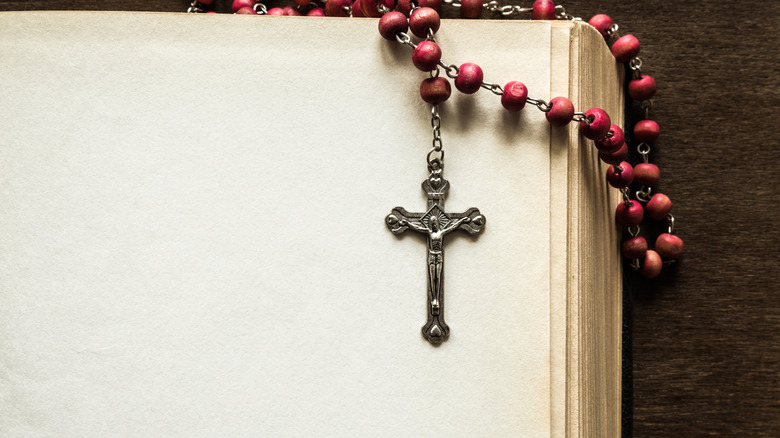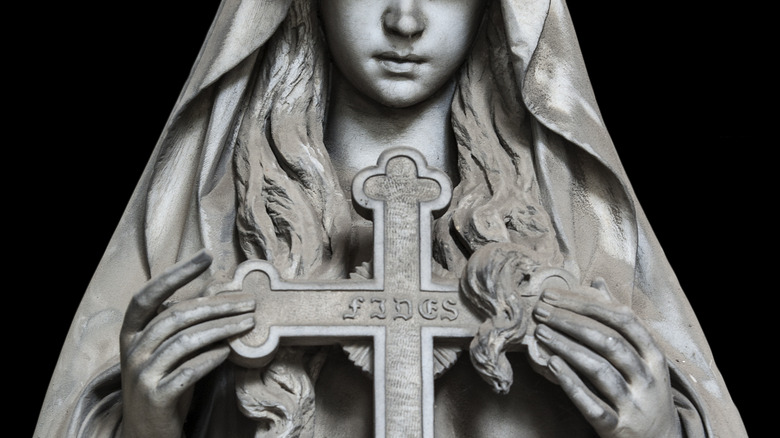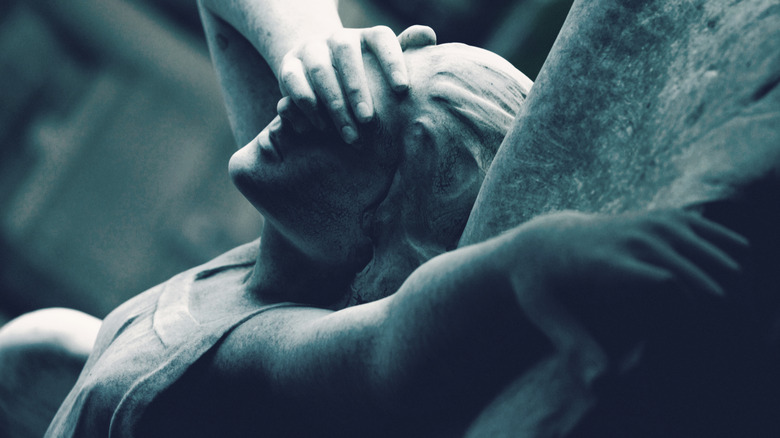Why A Dutch Nun Voluntarily Imprisoned Herself For 57 Years
Walking along the cozy cobblestone streets of Utrecht, Netherlands, alongside quaint canals and antique storefronts, you're bound to pass by one beautiful old church after another. As Discover Utrecht shows, there's the huge, Gothic, and imposing Dom, central to Utrecht's walkable downtown. There's the small, modest Sint Willibrordkerk, lushly decorated with ornate figurines and colorful scrollwork. There's the blue-painted brick and chandeliers of Gertrudis Cathedral, surrounded by green garden pathways. On and on the list goes.
One church, however — Buurkerk — could easily be mistaken for just another building. It's surrounded by clothing stores, shoe stores, and jewelers in the middle of a cluster of busy streets. It's been converted into a museum for self-playing musical instruments — Museum Speelklok — complete with everything from kids' do-it-yourself workshops to gigantic, all-instrument contraptions fed reams of dotted paper like massive music boxes. And on the third floor of that museum, up several flights of stairs and tucked into a corner with a little plaque, sits a dedication to Sister Bertken, born Berta Jacobsdochter.
Sister Bertken lived and died in that exact church, bricked up in the choir. As Museum Speelklok's Buurkerk history page says, she lived for 57 years in a tiny cell, eating, sleeping, reading, and praying, never stepping foot outside, and died at 87. She was what's called an "anchoress," someone who voluntarily walls themselves up with no doors in the stone of church, imprisoned for life. She also dispensed advice to folks who sought her out.
If walls could speak
Not much is known about Sister Bertken, although she became a familiar figure in Utrecht. As the book "An Introduction to Middle Dutch" recounts, she was born in 1426 to a "well-to-do family." Tiferet Journal (posted at Thrive Global) also says that she was the "illegitimate daughter of a priest," citing the plaque about her life in the Buurkerk — "the neighbor church." She chose to enter a convent when she was 26, and four years later sought permission to wall herself up. From that year on she lived every single day in her cell until she died in 1514 at the age of 87.
And make no mistake: Sister Bertken wasn't living in some cushy, well-appointed suite full of lavish furniture and tapestries. She had a mattress without a bedframe, a desk, and a chair. There were windows on different walls, each for a different purpose. One let in light from the outside world. Another was used for hygienic purposes and to pass along food and water. She never ate meat or dairy items, and consumed a "frugal diet." The last window was a little slot she could use to speak with visitors. The room never got any heat, and Sister Bertken never wore shoes. Netherlands winters are incessantly cold, gray, and damp. And because her room was composed of stone and without rugs, Sister Bertken must have been in constant discomfort, even pain.
Solitude, prayer, and intercession
At this point you might be thinking two things: a) Sister Bertken's room sounds an awful lot like a prison cell, and b) Why would anyone do that to themselves? To the first comment we say: Yes, that's the point. The answer to the latter question is trickier. Today, much of the world lives in an age of unprecedented historical luxury, with on-demand heat and light, private toilets and running water, widespread transportation and infrastructure, boundless food and clothing options, instant global communication, and a deluge of personalized entertainment options. Things weren't so cushy back in the 15th century. But to Sister Bertken it wouldn't have mattered, anyway.
To Sister Bertken, the "why" would have been simple: to give one's life to God. But rather than be completely disconnected in a convent, she and other anchoresses dwelled on the cusp of this world and the next. As Owlcation explains, anchoresses symbolically died when they were walled inside their room. The room was a tomb, and its occupant "dead to the world." Their tie to Earth was tenuous. When the last brick of Sister Bertken's wall was placed, it was like tossing the last clod of soil on a coffin. She'd been ritually buried, and could focus on meditation, prayer. Like other Catholic clergy, she interceded with the Almighty on behalf of a mad, obsessed, wayward world estranged from what Tiferet Journal (posted at Thrive Global) calls "original intent."
In her own words
To gain some insight into Sister Bertken's mind and motivations, we can look to her own words. She didn't write a lot during her 57 years as an anchoress, but as "An Introduction to Middle Dutch" says, we've got two "prose treatises" — philosophical discussions on theology — and some songs. She also wrote poetry, like that included in Mystics Quarterly, published by Penn State University Press (posted at JSTOR). It's possible that she wrote more, but the work didn't survive.
Sister Bertken's writing is graceful, delicate, and exceedingly pious. It focuses on the day-to-day experience of being a monastic and "how to attain to God," as historian Llewellyn Bogaers states in her essay, "Utrecht at a Crossroads: Religious affiliations in a sixteenth century Netherlandish city." Bogaers also considers the timing of Sister Bertken's self-imposed imprisonment. The anchoress walled herself into Buurkerk right at the onset of violent, sweeping religious change in the Netherlands during its Protestant Reformation, described further on World History Encyclopedia. In a way, her devotion embodied her country's upcoming religious zeal.
A tiny sample from Sister Bertken's poem "I went into the garden to gather herbs ..." in Mystics Quarterly illustrates her style perfectly: "If he lets drop his gentle dew, my lover / These seedlings shall grow and flower / He loves to see the lilies, my lover / If they grow straight and pure / When red roses are planted in the same bed / Then he touches the flowers with his gentle dew."
An ancient lineage of monks and nuns
Sister Bertken wasn't the first person to choose to be walled into a single room for life. She was one of a long line of women and men who'd done the same, going all the way back to the fourth century C.E., as the Catholic Diocese of Green Bay, Wisconsin describes in The Compass. At that time, monasticism was on the rise in Europe. Started by desert-dwelling hermits in Egypt in the late third century, monasticism — the basic notion of isolation from society to focus on God — spread and evolved into countless different orders of monks, as World History Encyclopedia says. By 1000 C.E., when Benedictine monasticism became the most widespread order, all monks adhered to the now-familiar precepts of poverty, chastity, and obedience, per Wondrium Daily.
Nuns adhered to those same precepts, and so did anchoresses like Sister Bertken. But while nuns lived in monasteries in community with other nuns, anchoresses lived alone. This meant that an anchoress wasn't "away from it all," as The Compass says, and was still connected to society through the literal walls of a church. Sister Bertken and other famous anchoresses like Countess Jutta von Sponheim, teacher of the legendary mystic Hildegard of Bingen, led a life "by which the Christian faithful devote their life to the praise of God and the salvation of the world through a stricter withdrawal from the world, the silence of solitude, and assiduous prayer and penance."
What remains of a life
As The Utrecht Archives says, Sister Bertken was buried on the grounds of Buurkerk, the church where she lived the final 57 years of her life. The exact location of her grave is unknown because of renovations made to the church. In addition to the aforementioned dedication to Sister Bertken inside Museum Speelklok, there's a little stone plaque at ground level outside of the building. Located along one of Utrecht's many canals and on an adjacent street, Choorstraat, it simply says, "Suster Bertken" in Dutch. It depicts a scene of Sister Bertken in her room with one person on the right approaching her for advice, and another on the left passing her a loaf of bread through a window. We've been left with these memorials, her writings, and her memory in the streets of Utrecht.
As for truly understanding Sister Bertken and others who chose to be anchoresses, Bertken herself explains it best — specifically, one prose treatise titled "A Pious Colloquy Between the Loving Soul and her Beloved Bridegroom Jesus." Published by Penn State University Press in Mystics Quarterly and available on JSTOR, it reads, "As I was very poor in this world, so you too should be. I was spotless and you too should avoid being tainted by the world. I suffered from my early youth, so should you. Since I did this all for love of you, you should do this all for love of me and my honor."

